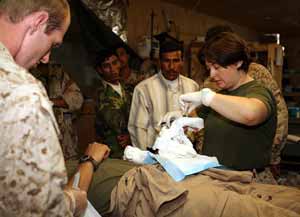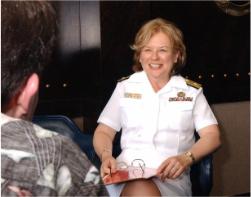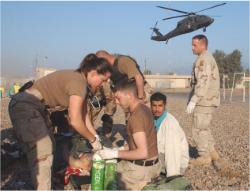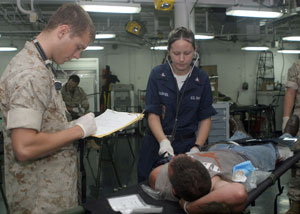
|
Lesson 7: The Role of the Practical Nurse
a. The practical nurses' role has expanded to team leadership and patient teaching. Leadership is defined as influencing individuals or groups to take an active part in the process of achieving agreed-upon goals. Nursing leadership may be defined as a process of interpersonal influence through which a patient is assisted in the establishment and achievement of goals toward improved well-being.
b. Teaching refers to activities by which specific objectives or desired behavior changes are achieved. It is an interactive process between the teacher and one or more learners. Patient teaching is inherent to the role of nursing by virtue of the nurse's position at the bedside. Shorter hospital stays which require patients to manage convalescence at home, and emphasis on health promotion and health maintenance rather than on treatment alone, have increased the need for health teaching by nurses.
Section I. TEAM LEADERSHIP
a. In 1953, Eleanor Lambertson and her colleagues proposed a system of team nursing to overcome the fragmentation of care resulting from the task-oriented functional approach. Team nursing responds to the needs of both the patient and the staff. Team members are stimulated by the team leader to learn and develop new skills. The team leader instructs the team members, supervises them, and provides assignments that offer them potential for growth. The following facts define team nursing:
|
(1) It is direct patient care accomplished by a specific group of nurses and allied health care workers.
(2) It is accomplished by using the nursing process.
(3) It allows for comprehensive, holistic nursing care when the team functions at a high level of efficiency.
(4) It is composed of a team leader who coordinates patient care and supervises team members, and team members who are responsible for total care given to an assigned group or number of patients.
(5) It requires cooperation and effective communication with all staff members.
b. Basic to team nursing are the team conference, nursing care plan, and leadership skills.
(1) The conference is led by the team leader, and all personnel assigned to the team should be included. The team leader should discuss the needs of the patients, establish goals, individualize the plan of care for each patient, instruct the team members, and follow up on all directions previously given to the team.
(2) The nursing care plan is a written guide that organizes information about a patient's health. It focuses on the actions that must be taken to address the patient's identified nursing diagnoses and meet the stated goals. It provides for continuity of care by a constantly changing nursing staff. The team leader starts the care plan as soon as the patient is admitted to the medical treatment facility. In response to changes in the patient's condition, and evaluation of goal achievement, the nursing care plan is updated and revised throughout the patient's hospital stay.
(3) Three leadership styles have been described: autocratic, democratic, and laissez-faire. The three are sometimes blended to fit the situation, the needs of the team leader, and/or the needs of the nursing team.
(a) Autocratic leadership. The leader determines policies and gives orders and directions to the members. Autocratic leadership often makes team members dissatisfied. It may be a necessary style when urgent decision-making is required.
(b) Democratic leadership. The leader encourages team discussion and decision-making. This supportive style increases team productivity and satisfaction. Democratic leadership has positive connotations but requires time for discussion. It may not always be the most effective method when team members lack the skills to make decisions or when urgent decision-making is required.
(c) Laissez-faire leadership. The leader participates minimally and acts as a resource person and consultant at the request of the team members. Laissez-faire leadership is described as a "hands-off" approach. It is most effective after the team has made a decision, is committed to that decision, and has the expertise to implement it.
7-3. FACTORS AFFECTING TEAM PRODUCTIVITY
a. Productivity implies effectiveness and efficiency in individual and group performance. To be effective, the objectives must be achieved. To be efficient, the objectives must be achieved with the least amount of resources. Productivity implies measurement. Productivity involves the relative use of skills and the relative use of knowledge. Measurement of skills work is easy, but it becomes more difficult to measure knowledge work. The 91B10 may take and record vital signs of 20 patients in one hour. The team leader may use eight hours completing next month's schedule, while directing subordinates. One difficulty in measuring the productivity of knowledge work is that often the output contributes indirectly to achieve end results. Factors affecting the nursing team's productivity are:
(1) The number of team members. A team that is too large wastes time and fosters indecision. The team should be large enough to complete the assigned tasks, but small enough for adequate communication among its members.
(2) The number of assignments. Whatever the situation, the team members must learn to organize their work so that they are able to give adequate care to all of their patients.
(3) The types of tasks to be accomplished. Team members should be competent in performing all tasks that may be assigned. Non-nursing tasks such as answering the telephone, emptying the garbage, and transporting non-acute patients should be eliminated from their duties.
(4) The time allocated to complete the tasks. As conservation of scarce resources such as time, money, and supplies is more vigorously enforced, the need for nurses to be "faster and smarter" in delivering patient care will increase.
(5) The environment. A smaller staff will be on duty during the evening and night. There will be fewer members to a team, and each member will be assigned to care for more patients. Although more personnel are available during the day shift, more patient services are provided. Continuity of care is the key; communication between shifts is vital.
(6) The management style of the team leader. Whether the team leader has an autocratic, democratic, or laissez-faire management style, he must have a thorough knowledge of nursing and an intuitive understanding of human behavior if the team is to produce efficiently.
(7) The skills and experience of each team member. Each team member should have the needed skills for the technique, treatment, or procedure they are to perform. If in doubt, they should know where to find the SOP (standing operating procedures) if required.
|
b. Although the terms management and leadership are sometimes treated as synonyms, there is a distinct difference between a manager and a leader. The key functions of a manager are planning, organizing, staffing, leading, and controlling. Leadership is an important aspect of managing; however, there can be leaders of completely unorganized groups.
(1) A manager plans and sets up the organizational structure and assigns specific people to accomplish specific tasks.
(2) A leader influences people to be enthusiastic and willing to achieve the desired goals. Leadership and motivation are closely connected.
(3) Team leadership requires some management skills as well as leadership skills.
a. Although many great nursing leaders emerged in the past, most nurses were kept in subordinate positions. This subordination has diminished as more nurses learn to apply their leadership skills to attain the ultimate goal of improved patient care. Nurses with leadership skills can effect desired changes in the patient's health patterns, in the medical treatment facility, in the nursing profession, and in the community.
b. Many adjectives are used to describe the traits or qualities of a leader. With education, training, and practice, every nurse can develop the following leadership qualities.
(1) Professional knowledge. Nursing involves knowledge in biology, nursing science, social science, and many other areas. It is impossible to master them all. Learn how to find and use appropriate reference materials and resource persons quickly and efficiently. Keep up with current nursing practices for validity, reliability, and applicability and share your knowledge with peers and subordinates. Political awareness is also required. Know how local, state, and national level legislation will affect health care before supporting candidates or voting. Good leaders must be advocates of patient's rights in order to improve patient care.
(2) A positive self-image. Leaders must be enthusiastic, dynamic, and self-directed. They must be comfortable with themselves and act as role models to followers.
(3) Effective communication. Leaders must communicate effectively in order to relate to others. The ability to communicate effectively is especially needed when relating to patients, peers, subordinates, and superiors. Effective communication skills are used to:
(a) Share information with team members and involve them in the decision-making process.
(b) Define specific expectations.
(c) Offer suggestions and assistance in the completion of tasks.
(d) Elicit feedback from team members and provide feedback to superiors.
(e) Give constructive criticism and offer positive reinforcement to subordinates.
(f) Practice active listening.
(4) Assertiveness. Leaders need to be assertive in team interaction and other leadership situations. Assertiveness is used extensively when effecting change. Many nurses participate in assertiveness training programs so they can strengthen the position of nursing in the health-care system and increase its influence on patient care.
(5) Flexibility. Changes in the needs of patients, families, and the nursing team can occur within minutes. The nursing role and all nursing functions require flexibility.
(6) An understanding of human needs. The highest level on Maslow's hierarchy of needs is self-actualization, which is the need for an individual to reach his or her potential through full development of their unique capabilities. Effective leaders seek ways to promote self-actualization in themselves and team members. An effective leader understands the human need to feel useful and important, and the desire to belong, and to be recognized as an individual.
7-5. TEAM LEADER RESPONSIBILITIES
a. The National Federation of Licensed Practical Nurses (NFLPN) Revised Statement of Functions and Qualifications of the Licensed Practical Nurse states that the licensed practical nurse, with additional preparation in specialized areas and under direction of autonomous health professionals, is qualified to:
(1) Supervise other nursing and health-related personnel.
(2) Coordinate and make assignments of other nursing and health-related personnel and patients.
(3) Serve as team leader.
(4) Serve as charge nurse.
b. All members on a nursing team work together under the direction of the physician to help the patient return to his optimum function as quickly as possible. The team leader's responsibilities are:
(1) To attend change of shift reports. The change of shift report may be given to the entire oncoming shift in one area or it may be given in "walking rounds." In walking rounds, the departing nurse moves from patient to patient as he or she gives the report to the oncoming staff. This enables the oncoming staff to view the patient's equipment and dressings as the departing nurse reports what has occurred during her shift.
(2) To assign personnel. Personnel assignments are made with the patient's needs and each team member's proficiency in mind. The team leader reviews the nursing care plan, provides each team member with a written assignment sheet, and discusses the assignment with each member. The team leader also assigns breaks and lunch time.
|
(3) To assist team members with patient care. The team leader may assist with patient care as needed, but usually supervises the care that team members provide and sees that the goals of patient care are being met. He explains procedures to team members.
(4) To coordinate staff activities. The team leader coordinates staff activities to ensure quality patient care. The team leader attends patient care conferences and provides input to the Nursing Care Plan. He keeps abreast of any changes in patient status. He ensures utilization of quality assurance and infection control policies.
(5) To motivate the team. The team leader motivates the team to give skilled nursing care. Self-esteem, status, affiliation with others, affection, giving, accomplishment, and self-assertion are regarded as secondary needs. These needs vary in intensity with various individuals. The team leader must do or say those things, which will influence the team members to act in the desired manner (give skilled nursing care).
(6) To make final rounds. About one hour before the shift ends, the team leader should begin final rounds to observe and assess patient care and patient needs, and to see that everything is in order before the staff goes off duty for that shift. In making final rounds, the team leader would include the following:
(a) Check for completion of assignments.
(b) Check input/output (I&O) sheets.
(c) Check intravenous (IV) infusions and nasogastric (NG) intubations.
(d) Review nursing documentation.
(e) Talk to the patients. Gather information for the change of shift report. Listen for compliments or complaints concerning nursing care.
(f) Thank team members and give constructive feedback to those team members who were unable to complete their assignments.
(7) To complete nursing care rounds. The team leader should visually assess individual patients following the change of shift report.
The Brookside Associates Medical Education Division is dedicated to the development and dissemination of medical information that may be useful to medical professionals and those in training to become medical professionals. This website is privately-held and not connected to any governmental agency. The views expressed here are those of the authors, and unless otherwise noted, do not necessarily reflect the views of the Brookside Associates, Ltd., any governmental or private organizations. All writings, discussions, and publications on this website are unclassified.
© 2007 Medical Education Division, Brookside Associates, Ltd. All rights reserved



